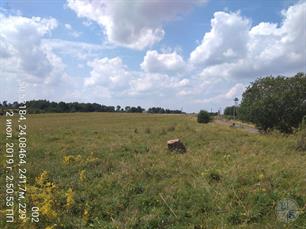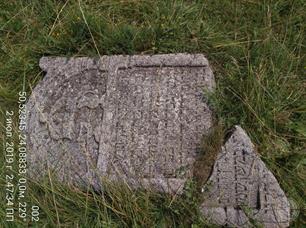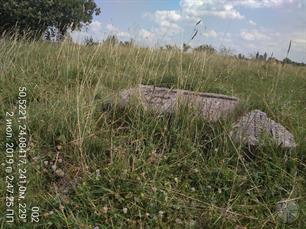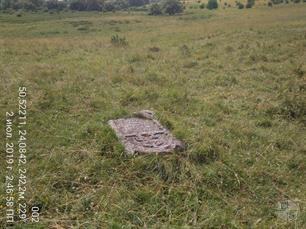Varyazh
Sources:
- Russian Jewish encyclopedia
- Virtual Shtetl. Waręż
- Holocaust in the USSR, ed. I. A. Altman, Moscow 2009
Photo:
- Jewish Cemeteries Initiative. Varyazh Jewish Cemetery
- Russian Jewish encyclopedia
- Virtual Shtetl. Waręż
- Holocaust in the USSR, ed. I. A. Altman, Moscow 2009
Photo:
- Jewish Cemeteries Initiative. Varyazh Jewish Cemetery
Chervonohrad district, Lviv region
Varyazh (ukr. Варяж, in 1951–89 - Novoukrainka), a village in Lviv region. In the 16-18 centuries - part of the Commonwealth. In 19 - beginning 20th century - township in Sokal district of Galicia as part of Austria-Hungary. In 1919–39 - as part of Poland, in 1939–91 - Ukrainian SSR.
In 1880, 911 Jews lived in Varyazh (68%),
in 1900 - 1486 (65%),
in 1921 - 520 Jews (54%).
In 1539 Varyazh received the status of city.
The first information about Jews in Varyazh dates back to 1573.
Jews earned a living with petty trade, craft and agriculture.
The Jewish community existed in Varyazh since the end of 18th century.
Rabbi in Varyazh since 1886 was Pinhas Eizen (1845-1915), since 1910 - Sholom Babad (1877-1943), then his son-in-law Avrom-Mordhe Ashkenazi (1883-1943), later expelled by the Soviet authorities to Siberia and dead there.
Most of the Jews Varyazh were the Belzer Hasids, some belonged to the Ruzhin and Gusyatin Hasidic movements.
During the period of Partitions, Varyazh came under the Austrian rule. In 1880, the town had 911 Jewish inhabitants, who constituted ca. 68% of the population (1,336 people in total).
Over the following years, the number of Jews living in the town grew proportionally to the development of Varyazh and reached its peak at 1,486 (invariably constituting ca. 65% of the population). Soon, however, people started to emigrate and move to bigger towns.
Right before WWI, Orłowicz estimated the population of the town at 1,500 people, including 1,000 Jews. Using vaguely anti-Semitic wording, he wrote that in Waręż there was “the palace of the Łomnicki Counts in the market square, surrounded by dirty Jewish houses”
Zionist organizations began to operate in Varyazh after the 1st World War. There was a small group of Jewish communists (including the only doctor in Varyazh Dr. Gangel).
The population shrank significantly after 1st World War – 520 Jews lived in the town in 1921, constituting 54% of all the town’s inhabitants.
Jews worked in trade (textiles, varied goods, leather, tobacco, grain, iron) and crafts (tinsmithing, tailoring, carpentry).
There were six innkeepers in the town, e.g. Erdman, Grьner, Reiman i Unger. O. Steinberg owned a groats production plant, while Schifschьler and Sьsser ran an oil mill. L. Schichter had a wool combing plant. There were also several slaughterhouses.
In Varyazh there were a bank for mutual assistance, created in the 1920s, a voluntary fire team, charitable organizations.
In 1923, the Jewish library was opened.
After the outbreak of WWII, most local Jews fled to the Soviet territory. The town itself was located in the German occupation zone.
In the years 1941–1942, a German labour camp was open in Varyazh; several hundred Jews were murdered there.
In 1942, all Jewish people still living in the town were killed in the German extermination camp in Bełżec.
In 1880, 911 Jews lived in Varyazh (68%),
in 1900 - 1486 (65%),
in 1921 - 520 Jews (54%).
In 1539 Varyazh received the status of city.
The first information about Jews in Varyazh dates back to 1573.
Jews earned a living with petty trade, craft and agriculture.
The Jewish community existed in Varyazh since the end of 18th century.
Rabbi in Varyazh since 1886 was Pinhas Eizen (1845-1915), since 1910 - Sholom Babad (1877-1943), then his son-in-law Avrom-Mordhe Ashkenazi (1883-1943), later expelled by the Soviet authorities to Siberia and dead there.
Most of the Jews Varyazh were the Belzer Hasids, some belonged to the Ruzhin and Gusyatin Hasidic movements.
During the period of Partitions, Varyazh came under the Austrian rule. In 1880, the town had 911 Jewish inhabitants, who constituted ca. 68% of the population (1,336 people in total).
Over the following years, the number of Jews living in the town grew proportionally to the development of Varyazh and reached its peak at 1,486 (invariably constituting ca. 65% of the population). Soon, however, people started to emigrate and move to bigger towns.
Right before WWI, Orłowicz estimated the population of the town at 1,500 people, including 1,000 Jews. Using vaguely anti-Semitic wording, he wrote that in Waręż there was “the palace of the Łomnicki Counts in the market square, surrounded by dirty Jewish houses”
Zionist organizations began to operate in Varyazh after the 1st World War. There was a small group of Jewish communists (including the only doctor in Varyazh Dr. Gangel).
The population shrank significantly after 1st World War – 520 Jews lived in the town in 1921, constituting 54% of all the town’s inhabitants.
Jews worked in trade (textiles, varied goods, leather, tobacco, grain, iron) and crafts (tinsmithing, tailoring, carpentry).
There were six innkeepers in the town, e.g. Erdman, Grьner, Reiman i Unger. O. Steinberg owned a groats production plant, while Schifschьler and Sьsser ran an oil mill. L. Schichter had a wool combing plant. There were also several slaughterhouses.
In Varyazh there were a bank for mutual assistance, created in the 1920s, a voluntary fire team, charitable organizations.
In 1923, the Jewish library was opened.
After the outbreak of WWII, most local Jews fled to the Soviet territory. The town itself was located in the German occupation zone.
In the years 1941–1942, a German labour camp was open in Varyazh; several hundred Jews were murdered there.
In 1942, all Jewish people still living in the town were killed in the German extermination camp in Bełżec.

- Home
- Shtetls
- Vinnytsia region
- Volyn region
- Dnipro region
- Donetsk region
- Zhytomyr region
- Zakarpattia region
- Zaporizhzhia region
- Ivano-Frankivsk region
- Kyiv region
- Kropyvnytskyi region
- Luhansk region
- Lviv region
- Mykolayiv region
- Odessa region
- Poltava region
- Rivne region
- Sumy region
- Ternopil region
- Kharkiv region
- Kherson region
- Khmelnytskyi region
- Chernihiv region
- Chernivtsi region
- Cherkasy region
- Crimea
- Synagogues
- Cemeteries
- Objects & guides
- Old photos
- History
- Contact
Jewish towns of Ukraine
Jewish towns of Ukraine
My shtetl
My shtetl
Donate




